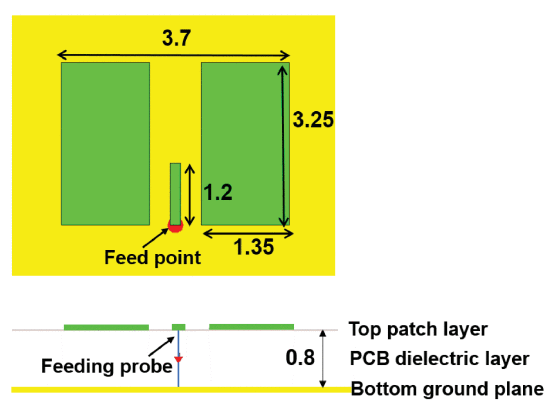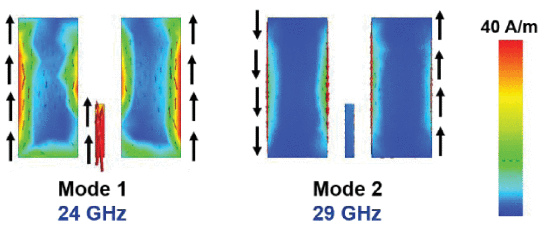Engineers and researchers are always looking for ways to strengthen mobile connectivity. In a paper entitled “A Capacitive Coupled Patch Antenna Array With High Gain and Wide Coverage for 5G Smartphone Applications,” a group of researchers propose using 3D printing to create a new kind of capacitive coupled patch antenna array capable of providing high gain and 360-degree coverage in the elevation plane.
“The proposed antenna is a pair of compact capacitive coupled symmetric patches as shown in Fig 1,” the researchers explain. “The overall size of the proposed design is 3.7 mm ×3.25 mm. Rogers RT5880 of a relative dielectric constant 2.2 and loss tangent 0.0009 at the frequency band of 24–28 GHz is used as the substrate for printed circuit board (PCB). The patches are printed at the top layer of the substrate. The bottom layer of the substrate consists of the ground plane. The inner conductor of the coaxial probe feed extends from the ground plane through the PCB substrate to reach the top layer feed which capacitively couples the patches.”
The antenna element covers 24-28 GHz, which is a possible frequency band for future 5G applications. Four sub-arrays of 12 antenna elements, each providing 90 degrees in the elevation plane, were integrated into the mobile phone chassis for 360-degree coverage.
“The antenna array achieved a high gain of 16.5 dBi in the boresight and can be steered from −60° to 60° in the phi plane,” the researchers continue. “The proposed antenna exhibited a stable gain and uniform radiation pattern throughout the intended frequency band.”
The physical size of the antenna is relatively small compared to existing designs, meaning that it consumes less space and more antenna elements can be arranged along the width of the mobile phone ground plane. The bandwidth of the antenna is sufficient for 5G applications and can be further widened by modifying the antenna structure.
The researchers also modified the mobile phone chassis to accommodate the antenna arrays. The mobile phone’s PCB was reshaped from flat to three-dimensional, which the researchers call a “futuristic approach.” The 3D PCB utilizes the thickness of the entire mobile phone, which is typically 7-9 mm, and can provide mechanical support to the entire phone like a casing. By using a 3D rather than a flat shape, the researchers created more space for placing PCB components in the mobile phone, particularly for the additional 5G antenna elements along with the corresponding RFIC.
“The proposed arrangement consists of four sub-arrays with three sub-arrays of proposed antenna elements on different sides of the bottom edge region in PCB and one sub-array at the sides of the top edge region in PCB,” the researchers explain. “…Each sub-array has 12 antenna elements and 48 antenna elements are used altogether. Each sub-array provides 90° coverage in the theta plane.”
3D printing allowed the researchers to fabricate the antenna arrays in their novel configuration. They then conducted a thorough study of the antenna performance, and concluded that their 3D design may be useful in the future for the creation of mobile devices with 5G capabilities and higher.
Authors of the paper include Manoj Stanley, Yi Huang, Hanyang Wang, Hai Zhou, Ahmed Alieldin and Sumin Joseph.
Discuss this and other 3D printing topics at 3DPrintBoard.com or share your thoughts below.
Subscribe to Our Email Newsletter
Stay up-to-date on all the latest news from the 3D printing industry and receive information and offers from third party vendors.
You May Also Like
Meltio Expands Global Reach with New Partnerships in the Americas and Europe
Spanish 3D printing manufacturer Meltio has expanded its sales network across the globe. With the addition of three new partners in the United States, Brazil, Argentina, and Italy, Meltio aims...
3D Printing Webinar and Event Roundup: April 7, 2024
Webinars and events in the 3D printing industry are picking back up this week! Sea-Air-Space is coming to Maryland, and SAE International is sponsoring a 3D Systems webinar about 3D...
On the Ground in Linares, Spain for the Meltio M600 Launch
As detailed in a previous post, metal 3D printer manufacturer Meltio launched its latest wire-laser metal deposition (LMD) machine, the Meltio M600, at its headquarters in Linares, Spain. There, I was...
Blue Laser-powered M600 3D Printer Launched by Meltio
Founded in 2019 as a joint venture between Additec and Sicnova, metal 3D printer OEM Meltio develops and manufactures high-performance and easy-to-use metal 3D printing solutions that use its patented wire-laser metal...

































